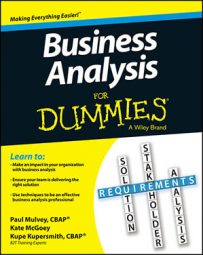Good communication skills are vital to a business analyst’s success. We live in a time when so many barriers — some of which even seem to be socially acceptable — hinder communication. The more you understand how these obstacles can get in the way, the more you’re prepared to overcome them and be a great communicator.
Try to minimize outside distractions so you can focus on your stakeholder completely. Mobile phones and their land-line brethren, for example, are great communication tools, but when the phone goes off, let it ring. Better yet, turn it to silent or off completely when you’re with stakeholders.
If you’re expecting an important call, notify the person who comes in and sits down that if that call comes through, you’ll have to take it.
Be aware of and address culture and language differences directly. As a business analyst, you work with different people all the time, so it’s practically a given that you’ll work with people who have different cultures — maybe even languages — from you. And culture and language aren’t just about nationality; they can also be about the company itself.
When you join a new project, take time upfront to observe how people speak, carry themselves, and interact. Share a bit about your communication style, too. Doing so sets the foundation for open dialogue later down the road if a misunderstanding occurs over words.
Note any special needs and be sure to check in throughout the project to make sure your stakeholders understand you and that you understand them. For example, perhaps a stakeholder is hard of hearing. To prevent that person from missing out on important information, maybe you always come to meetings with pretyped notes or an agenda so everyone can follow along.
Don’t let your past experiences determine your future. Just because the previous project data administrator was a real jerk doesn’t mean the next one will be — or vice versa. Each person has his or her own unique personality. Consciously remind yourself to not let prior experiences with others get in the way of your current relationship.
Keep meetings from running too long. Do you how long a meeting can be before people check out and start doing something else? Two hours? One hour?
Each company’s individual culture dictates the actual number, but 1 to 1.5 hours is generally about the maximum period people can stay focused without drifting off to e-mail and other tasks. That number is even less if the meeting is a teleconference. If you have to conduct meetings longer than 1 hour, work in a 10-minute break every hour.
One final pointer to facilitate effective communication: Always ask the stakeholders how best to communicate with them; don’t automatically assume you know their preferences.

